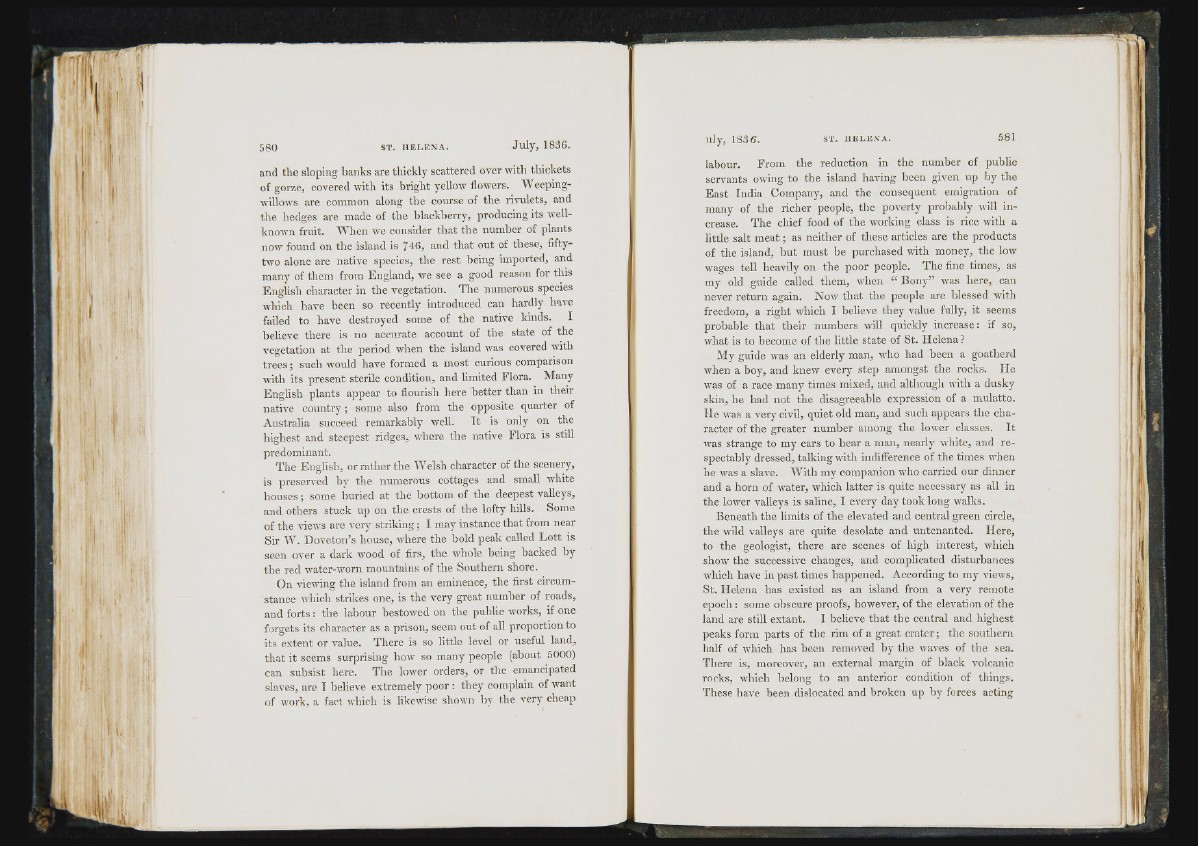
and the sloping banks are thickly scattered over with thickets
of gorze, covered with its bright yellow flowers. Weeping-
wili ows are common along the course of the rivulets, and
the hedges are made of the blackberry, producing its well-
known fruit. When we consider that the number of plants
now found on the island is 746, and that out of these, fifty-
two alone are native species, the rest being imported, and
many of them from England, we see a good reason for this
English character in the vegetation. The numerous species
which have been so recently introduced can hardly have
failed to have destroyed some of the native kinds. I
believe there is no accurate account of the state of the
vegetation at the period when the island was covered with
trees; such would have formed a most curious comparison
with its present sterile condition, and limited Flora. Many
English plants appear to flourish here better than in their
native country; some also from the opposite quarter of
Australia succeed remarkably well. It is only on the
highest and steepest ridges, where the native Flora is still
predominant.
The English, or rather the Welsh character of the scenery,
is preserved by the numerous cottages and small white
houses; some liuried at the bottom of the deepest valleys,
and others stuck up on the crests of the lofty hills. Some
of the views are very striking; I may instance that from near
Sir W. Doveton’s house, where the bold peak called Lott is
seen over a dark wood of firs, the whole being backed by
the red water-worn mountains of the Southern shore.
On viewing the island from an eminence, the first circumstance
which strikes one, is the very great number of roads,
and forts : the labour bestowed on the public works, if one
forgets its character as a prison, seem out of all proportion to
its extent or value. There is so little level or useful land,
that it seems surprising how so many people (about 5000)
can subsist here. The lower orders, or the emancipated
slaves, are I believe extremely poor : they complain of want
of work, a fact which is likewise shown by the very cheap
labour. From the reduction in the number of public
servants owing to the island having been given up by the
East India Company, and the consequent emigration of
many of the richer people, the poverty probably will increase.
The chief food of the working class is rice with a
little salt meat; as neither of these articles are the products
of the island, but must be purchased with money, the low
wages tell heavily on the poor people. The fine times, as
my old guide called them, when “ Bony” was here, can
never return again. Now that the people are blessed with
freedom, a right which I believe they value fully, it seems
probable that their numbers will quickly increase: if so,
what is to become of the little state of St. Helena ?
My guide was an elderly man, who had been a goatherd
when a boy, and knew every step amongst the rocks. He
was of a race many times mixed, and although with a dusky
skin, he had not the disagreeable expression of a mulatto.
He was a very civil, quiet old man, and such appears the character
of the greater number among the lower classes. It
was strange to my ears to hear a man, nearly white, and respectably
dressed, talking with indifference of the times when
he was a slave. With my companion who carried our dinner
and a horn of water, which latter is quite necessary as all in
the lower valleys is saline, I every day took long walks.
Beneath the limits of the elevated and central green circle,
the wild valleys are quite desolate and untenanted. Here,
to the geologist, there are scenes of high interest, which
show the successive changes, and complicated disturbances
which have in past times happened. According to my views,
St. Helena has existed as an island from a very remote
epoch : some obscure proofs, however, of the elevation of the
land are still extant. I believe that the central and highest
peaks form parts of the rim of a great crater; the southern
half of which has been removed by the waves of the sea.
There is, moreover, an external margin of black volcanic
rocks, which belong to an anterior condition of things.
These have been dislocated and broken up by forces acting